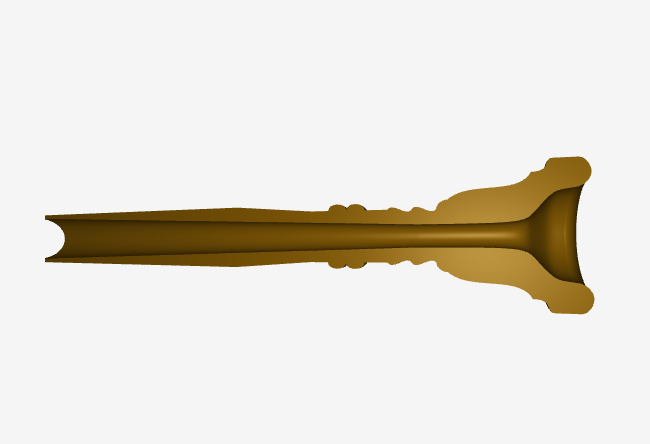Blog
Middlesex Music Archaeology Day
December 9th 2024 The Grove Atrium Middlesex University The Burroughs Hendon NW4 2BT
When the Romans replaced the Salpinx with the Tuba
For many centuries, the salpinx held its position as announcer in the Greek games or agon.
Download your Mouthpiece: The Open Mouthpiece designer
In March, we introduced a free site that offered an online mouthpiece designer.
Introducing: The Open Mouthpiece designer
Introducing an exciting new site that allows you, as a brass instrument player, to design and 3D print a mouthpiece for your instrument, starting from one of the pre-designed models on the site.
PUKKU, pututara, putarino, bucina
Throughout the ancient world, there are many names given to brass instruments which incorporate the pu/bu sound.
Rock Gongs Why do Ringing Rocks Really Ring
When a solid rock is hit by a striker, the area of concussion is compressed by the blow.
Ringing Stones and Rock Gongs
OK, this is a bit of a diversion from brass instruments but, when I was attending a conference many years ago and sat through a really boring presentation, I began thinking about a question a colleague had asked just before a session.
Vikings: Making Brass from Wood - Part 1
Part 1 of 3 Despite their reputation for rape and pillage and the signs of their presence over much of Europe, the evidence for the Viking horns or trumpets comes from their heartland in the western Baltic.
Music Archaeology: the Early Days
Music Archaeology: the Early Days Music archaeology didn’t burst upon the scene.
Early Music Archaeology in Ireland and the UK
Early Music Archaeology in Ireland and the UK The modern story of the Irish Horns started in 1726 with a second edition of Gerard Boate’s book.
Music Archaeology in Scandinavia and the Baltic
Early Music Archaeology in Scandinavia and the Baltic Region The reported modern story of the bronze lurs begins in Brudevaelte, Denmark in 1797 when a letter dated June 19th 1797, was penned to accompany the first find of lurs on their journey to the Royal Exchequer.
Music Archaeology of the Palaeolithic/Mesolithic/Neolithic
Sounds from Silence: Music Archaeology of the Palaeolithic, Mesolithic and Neolithic
Music Archaeology of the Mediterranean and Middle East
Music Emerging from the Texts While musical archaeology studies in the Mediterranean area and the Middle East have examined the physical evidence and iconography, written sources have always also played a key role.
Music Archaeology up to the 1960s
Music Archaeology up to the 1960s Brass instruments underwent monumental changes in the mid nineteenth century with the adoption of valves and one of the workers in the field at the time was Victor-Charles Mahillon, a Belgian musician, instrument builder and writer on musical topics.
Music Archaeology in Recent Times
What we Learn from our Predecessors Each generation of music archaeologists enjoys a huge advantage over its predecessor as technological developments offer the opportunity for greater exploration of the material available.
Animisation: Breathing Breath into Brass
The term animisation is used to describe the process where inanimate objects are granted animate powers.
When the Brass is Gender Fluid
Ethnographic evidence tells us that gender was attributed to sound tools in various ways, some of these being based only obliquely on the physical characteristics of males and females.
What is a Natural trumpet?
In many ways, the term ’natural trumpet’ is a bit strange as it doesn’t refer to a trumpet which grows in the soil or is dug up from the ground but just one which has no devices on it such as valves or slides or fingerholes.
What Instruments appear on Coins in the Ancient World?
Coins are an important source of information for music archaeologists. They may be small but the skill of the ancient die maker who makes the two dies which contain the impression of the two sides of the coin was amazing.
When is a Lur not a Lur
When the great, curved Bronze-Age horns were found in Scandinavia and the Baltic Region, no-one knew how old they were or what they might have been called.
When did the Trumpet and Keyboard First Get Together?
We can’t say exactly when these two instruments first came to be played together but it certainly didn’t take long after Ktesibios invented the first keyboard instrument.
Enjoying the Craic: The Irish Horns
One of the highlights of the Bronze-Age brass is the Irish Horns, over one hundred instruments which were found all over Ireland.
Spain’s Unique Iron-Age Brass
Although instruments throughout the Iron-Age world differed, there was considerable similarity both in instrument form and usage.
When did Brass first Appear in Brass Instruments?
Cast Brass Reproductions of the Pompeii Cornua Support-Bar Bosses Despite their name, brass only appeared in brass instruments relatively recently.
Who Studies Ancient Brass Instruments?
Well, lots of people, really. However, it’s music archaeologists who study all aspects of music in the ancient world.
A Night in the Museum - just me and the Lurs
In June 1975, we set off for our Scandinavian/Baltic tour, my wife and I and two sons.
Who Lived in the First Brass Instruments?
The earliest brass instruments which have survived from Europe are the sea-shell trumpets which are often referred to as conch-shell trumpets - although I prefer to call them sea-shell trumpets.
When were Musical Instruments Not Musical Instruments?
The mention of the word Music will likely bring about a series of mental processes in which you relate the context of the word to your own experiences.
When did the Cornett(o) earn its Fingerholes?
There’s a couple of answers to this really, depending upon whether you stick to an instrument which had that particular name or whether you mean fingerhole instruments in general.
What were the Main Structures of Brass in the Ancient World?
It’s easy to think of ancient brass design as following that of modern instruments but that was simply not the case.
When the Air goes Round and Round
Today there are, in the main, just two brass instruments in which the air goes round in circles, the French horn and the Sousaphone although others, such as cornets have, in the past, been made in this way.
What is the Natural Harmonic Series?
This is the range of notes played on any brass instrument when no valves, slides or finger-holes are utilised.
What did the Greeks use their Trumpets for?
Strangely, the answer is simple, they used their salpinx (that’s what they called their trumpet) for pretty-well everything.
Spreading Brass on your Toast
The bronze lurs are among the most-characteristic instruments from the Late Bronze Age in northern Europe.
Why was the letter J popular among Iron-Age Brass Players?
Of course, it wasn’t the letter itself which made its claim of importance to brass players during the long, logo-ago European Iron Ages - between around 1000 BCE to sometime quite a lot later!
What were the two Tutankhamun Trumpets?
In 1922, British archaeologist, Howard Carter discovered the tomb of Tutankamun, one of the richest ever found.
When did the brass ensemble first appear?
Brass instruments had been around for a very long time before we see different instruments used together.
What’s in a name: Cornu?
The name cornu (plural cornua) appears in Roman literature, describing their instrument which encircled the player.
When Louis Met Me
When I started playing the cornet, my two heroes were Louis Armstrong and Eddie Calvert.
The Oldest Brass Instrument?
There’s quite a bit of talk about which is the oldest brass instrument around but, for my money, it terms of continuous tradition, it’s the instruments of the first Australians.
Why is iconography relevant?
The term iconography refers to all manner of illustrations and we rely on these to fill in information about instruments when the physical remains are either lacking or fragmentary.
What’s in a name: Lituus?
The term ’lituus’ is one applied to a ‘J’-shaped instrument used by the Romans.
Where did the first mouthpieces appear?
In Scandinavia and the Baltic region, during the late Bronze Age mouthpieces were developed to an astonishing degree.

